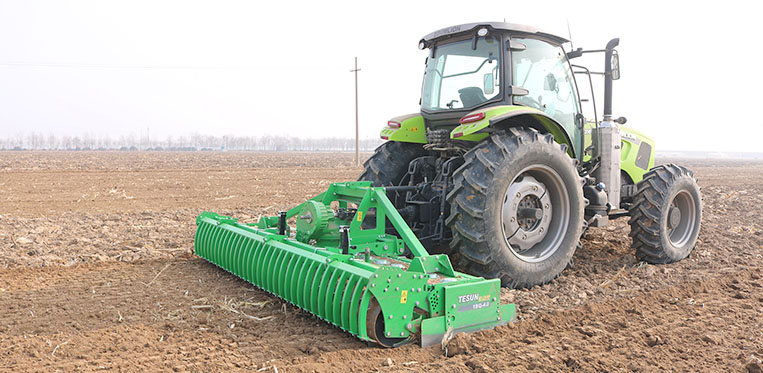No-tillage machines are popular with farmers because they can reduce operating costs, prevent soil erosion, and save energy. No-tillage machines are mainly used to grow crops such as grain, pasture or green corn. After the previous crop is harvested, the seed ditch is directly opened for sowing, so it is also called a live broadcast machine. In addition, the no-tillage machine can complete stubble removal, ditching, fertilization, sowing, and soil covering at one time. Today I will share with you how to use the no-tillage machine correctly.
Preparation and adjustment before operation
1. Tighten and spray oil. Before using the machine, check the flexibility of the fasteners and rotating parts, and then add lubricant to the rotating parts of the chain and other rotating parts. In addition, before operation, it is necessary to carefully check the relative position between the rotary knife and the trencher to avoid collision.
2. Adjustment of the seeding (fertilization) device. Coarse adjustment: Loosen the lock nut of the adjustment handwheel to disengage the ring gear from the meshing position, then turn the metering amount adjustment handwheel until the metering indicator reaches the preset position, and then lock the nut.
Fine-tuning: Hang up the crushing wheel, rotate the crushing wheel 10 times according to the normal operating speed and direction, then take out the seeds discharged from each tube, record the weight of the seeds discharged from each tube and the total weight of sowing, and calculate the average seeding amount of each row. In addition, when adjusting the seeding rate, it is necessary to clean the seeds (or fertilizer) in the seed (fertilizer) sheave until it does not affect the movement of the sheave. It can be debugged repeatedly. After adjustment, remember to lock the nut.
3. Adjust the level around the machine. Raise the machine so that the rotary knife and the trencher are off the ground, and then adjust the left and right tie rods of the tractor rear suspension to keep the rotary knife tip, the trencher and the machine level. Then continue to adjust the length of the tie rod on the tractor hitch to keep the no-till machine level.
USE AND ADJUSTMENT IN OPERATION
1. When starting, start the tractor first, so that the rotary knife is off the ground. Combined with the power output, put it into the working gear after idling for half a minute. At this time, the farmer should slowly release the clutch, operate the hydraulic lift at the same time, and then increase the accelerator to make the machine gradually enter the field until it runs normally. When the tractor is not overloaded, the forward speed can be controlled at 3-4 km/h, and stubble cutting and sowing meet the agronomic requirements.
2. Adjustment of sowing and fertilization depth. There are two adjustment methods: one is to change the length of the upper tie rod of the rear suspension of the tractor and the position of the upper limit pins of the rocker arms on both sides of the two sets of pressure wheels, and simultaneously change the depth of sowing and fertilization and the depth of tillage. The second is that the depth of sowing and fertilization can be adjusted by changing the installation height of the opener, but the relative position of the depth of the fertilizer remains unchanged.
3. Adjustment of pressure reducer. During the operation of the machine, the pressing force can be adjusted by changing the positions of the limit pins of the rocker arms on both sides of the two sets of pressing wheels. The more the upper limit pin moves down, the greater the ballast pressure.
Common problems and solutions.
Inconsistent sowing depth. On the one hand, this problem may be caused by an uneven frame, making the penetration depth of the trencher inconsistent. At this point, the suspension should be adjusted to keep the machine level. On the one hand, it may be that the left and right sides of the pressure roller are uneven, and the degrees of the adjustment screws at both ends need to be adjusted. Open broadcast questions. First, you can check whether the tire grooves of the tractor are not filled. If so, you can adjust the depth and forward angle of the sprinkler to make the ground level. Then it may be that the crushing effect of the crushing wheel is poor, which can be solved by adjusting the adjusting screws at both ends.
The amount of seeding in each row is uneven. The working length of the sowing wheel can be changed by moving the clamps at both ends of the sowing wheel.
Precautions for use.
Before the machine is running, obstacles on the site should be removed, the auxiliary personnel on the pedal should be stabilized to avoid personal injury, and inspection, maintenance, adjustment and maintenance should be carried out. The tractor should be turned off when working, and the implement should be lifted in time when turning, retreating, or transferring to avoid retreating during operation, reduce unnecessary downtime, and avoid accumulation of seeds or fertilizers and ridge breaking. In case of strong wind and heavy rain, when the relative water content of the soil exceeds 70%, operation is prohibited.
Post time: Aug-11-2023


